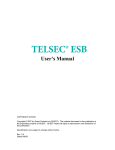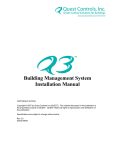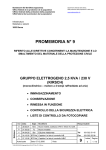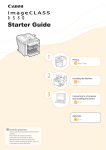Download User`s Manual - Quest Controls Inc.
Transcript
TELSEC® 500 HEAT EXCHANGER CONTROLLER User’s Manual Quest Controls, Inc. 208 9th Street Dr. West Palmetto, FL 34221 www.questcontrols.com Phone: (941) 729-4799 Fax: (941) 729-5480 Email: [email protected] TELSEC 500 Manual, V3.0, 9/9/09 TELSEC® 500 User’s Manual Table of Contents CHAPTER 1 – INTRODUCTION .......................................................................... 1 CHAPTER 2 – PRODUCT SPECIFICATIONS ..................................................... 2 CHAPTER 3 – INSTALLATION INSTRUCTIONS................................................ 5 CHAPTER 4 – PROGRAM SETUP & CONFIGURATION ................................. 13 CHAPTER 5 – APPLICATION ........................................................................... 20 CHAPTER 6 – OPERATION .............................................................................. 22 CHAPTER 7 – THE FRONT PANEL .................................................................. 25 CHAPTER 8 – SERVICE .................................................................................... 26 APPENDIX A – TEMPERATURE CONVERSION CHART ................................ 28 WARRANTY INFORMATION ............................................................................. 29 TELSEC 500 Manual, V3.0, 9/9/09 i TELSEC® 500 User’s Manual CHAPTER 1 – Introduction Congratulations on your purchase of a new TELSEC® 500 Heat Exchanger Controller! The Heat Exchanger Controller is a state-of-the-art electronic monitor and controller providing variable speed control of your heat exchanger fans and alarming for fan, fuse failure, high temperature and intrusion. This User’s Manual is intended to provide you with the information you need to get started with the TELSEC® 500, understand its specifications, how to install it, how to apply it, how to operate it, and how to service and maintain it. Please contact Quest Controls if you have questions or suggestions to improve this User’s Manual. COPYRIGHT NOTICE Copyright © 2002-07 by Quest Controls Inc (QUEST). The material discussed in this publication is the proprietary property of QUEST. QUEST retains all rights to reproduction and distribution of this publication. TELSEC® & ADAM™ are registered trademarks of QUEST. Specifications are subject to change without notice TELSEC 500 Manual, V3.0, 9/9/09 1 TELSEC® 500 User’s Manual CHAPTER 2 – PRODUCT SPECIFICATIONS 2.1 General The TELSEC® 500 combines alarming and control functions of heat exchangers into one package, allowing the user to save money on installation time and save valuable space inside the cabinet. The TELSEC® 500 provides on/off control as well as variable speed control of up to six fans. The fans are variable speed controlled from 40 to 100% duty cycle via PWM techniques. As temperature inside the cabinet increases/decreases, the fan speed changes proportionally to maintain proper temperature. The TELSEC® 500 implements pulse width modulation of the fan motors for variable speed control. The TELSEC® 500 offers the customer four distinct money saving advantages: 1) Utilizing variable speed control of the motors decreases a customer’s energy consumption needs, which in turn decreases his energy bill. This also shortens the run time of the fans, increasing the life expectancy. 2) Variable speed control allows the advanced functionality of reducing speed during power failure conditions. This increases battery capacity when necessary. Variable speed also allows reducing the maximum speed to comply with noise abatement or acoustical requirements. 3) Lower cost 2-wire heat exchanger fans can be used because the alarm and tachometer functions are built into the TELSEC® 500. This can result in significant savings in capital expenditures for fans. The TELSEC® 500 will continuously monitor for fan and fuse failure, and intrusion alarming. If an alarm condition occurs then the TELSEC® 500 will close an alarm contact and light the appropriate LED. The alarm contact closure can be tied into the environmental alarm monitoring system for alarm transportation to the alarm center. TELSEC 500 Manual, V3.0, 9/9/09 2 TELSEC® 500 User’s Manual 2.2 • • • • • • • • • • • • Features Variable Speed or On/Off Control of up to 6 Fans. Internal Tachometer generator monitors and alarms to user configurable tolerance range. Commercial powerfail speed reduction and/or automatic setpoint adjustment, which saves valuable battery capacity. User adjustable fan maximum speed clip ensures meeting your tight acoustical requirements. User programmable T-stat input sends fans to 100% or 0%. Fail-safe feature for hazardous conditions. Override button: turns all motors on full speed and alarms until the system is reset; override is cleared when cabinet doors are closed. Fans will run at full speed and an alarm condition will occur if the system experiences a logic failure or if in override. An alarm condition will also occur if there is a fuse failure, fan failure, or the -48VDC power is lost. Green/Red LEDs for each fan indicate status. Fan alarm reset: clears alarm conditions manually (on-site). Supports redundant (dual) power feed from power plant. Custom rack mounting option available. Inputs • Alarms up to 4 intrusion inputs. • Measures and alarms high temperature condition using 2 external temp sensors. • User programmable T-stat input sends fans to 100% or 0%. Fail-safe feature for hazardous conditions. • Commercial power fail input takes fans down to lower speed during battery discharge (extends battery life). Fan Outputs • Fan 1 – Fan 6: supplies each fan with -48VDC. Alarm Outputs • 1 High Temp: the contacts are wired NO and alarm on contact closure. • 1 Intrusion: the contacts are wired NO and alarm on contact closure. • 1 Fan/Fuse: the contacts are wired NO and alarm on contact closure. Fan Speed Selection • Fan speed is determined by the TELSEC® 500 based on internal cabinet temperature. TELSEC 500 Manual, V3.0, 9/9/09 3 TELSEC® 500 User’s Manual 2.3 Specifications Part # Voltage Current Alarm Outputs (Contact Rating) Ambient Operating Range RS232 port Terminals & Connections Fan Type Dimensions Weight Warranty 150663 Nominal 48VDC (44 to 56VDC) Fused at 2 amp for Module, 7.5 amps/fan at full speed (up to 45 amps total) 60VDC, 0.3 amps -40 to 180ºF (-40 to 82ºC) Configuration and maintenance. All connections are 2 piece type – plug in terminal Compatible with popular industry-standard ebm/PABST high-velocity fans. 1.95"(50mm) W X 19.1"(486mm) L X 4.4"(112mm) D 3.5 lbs (1.6 kg) 1 year Specifications are subject to change without notice 2.4 Outputs The TELSEC® 500 has three alarm and six Fan outputs: Name System/Fan/Fuse Alarm Intrusion Alarm High Temp Alarm Fan 1 – Fan 6 Contacts NO NO NO Function Closes relay contact on alarm Closes relay contact on alarm Closes relay contact on alarm Supply for the fans. 2.5 Inputs The TELSEC® 500 has five inputs. The list of inputs and function are as follows: Name Contacts Function Intrusion NO Monitors 4 doors in parallel using normally open contacts. T-stat NO Programmable to force fans to full or zero speed with a contact closure. PFail NO Commercial power failure input to reduce fan speed to preprogrammed minimum speed. Temp sensor 1 Temperature sensor for on/off or variable speed control. Temp sensor 2 TELSEC® 500 will control based upon the highest reading of both sensors. TELSEC 500 Manual, V3.0, 9/9/09 4 TELSEC® 500 User’s Manual CHAPTER 3 – INSTALLATION INSTRUCTIONS 3.1 Overview This chapter describes the hardware installation for the TELSEC® 500. For a general description, refer to Chapter 2 – Product Specifications. The design of the TELSEC® 500 (figures 1 & 2) allows rack mounting in a vertical or horizontal orientation inside any cabinet. ® Figure 1. TELSEC 500 front view Figure 2. TELSEC® 500 back view 3.2 Unpacking the System A complete system is ready for installation when it is removed from the shipping carton. This carton and the packaging material should be retained in case it becomes necessary to return the unit to the factory for repair. In addition to the TELSEC® 500, the following items will be found inside the carton: • Mounting hardware and grounding wire. • One temperature sensor with cable leads standard (optional second sensor). • User’s Manual in PDF format on enclosed CDROM. 3.3 Installation Tools The following items may be required for installation, in addition to the items provided by Quest: • • Hand Tools - Screwdrivers, wire cutters, pliers, etc. Crimping tool 3.4 Fan Configuration Prior to mounting the TELSEC® 500 take a moment to configure the unit for the number of fans and fan types being used. TELSEC 500 Manual, V3.0, 9/9/09 5 TELSEC® 500 User’s Manual 3.4.1 Number of Fans On the back of the unit are two switches that configure the number of fans to be connected to the system. The switch is located next to the Fan 6 connector. This needs to be set properly for the fan speed alarms to work correctly. Set switches as follows: # Of Fans Monitor 2 fans Monitor 4 fans Monitor 6 fans Connect To: FAN 1 & 2 FAN 1-4 FAN 1-6 Switch 1 Down Up Up Switch 2 Down Down Up 3.4.2 Setting Fan Type On the bottom of the TELSEC® 500 is a 6 position dip switch that sets the control style for each fan connected. There is one switch for each fan corresponding to FAN 1 to FAN 6 control ports. These switches are used only for 3 and 4 wire fans to set the proper operation of the control line. Two wire fans are not affected by the switch position. The following matrix shows the setting for fans that have been tested by Quest Controls. If your fan is not listed, please contact Quest Controls, Inc. with the fan specifications to verify a compatible setting prior to system operation. Improper switch settings may adversely affect the fan operation and/or life expectancy. Note that “ON” below means the switch should be pushed towards the back of the can. The location of the dip switch is illustrated in the figure below. The following table shows the settings for fans that have been tested: Switch Fan Manufacturer and Part # Position EBM R1G225-AC73-XX (where XX=36,38,39,52) ON EBM R1G225-AF11-XX (where XX=13,14) OFF EBM R1G225-AE07-11 OFF EBM R1G225-AG39-10 ON EBM R1F250-AQ00-XK OFF EBM R1G225-AG15-AA OFF TELSEC 500 Manual, V3.0, 9/9/09 6 TELSEC® 500 User’s Manual 3.5 Mounting the TELSEC® 500 The unit mounts to the rack using a mounting clip and mounting bolts. Slide the rear latches into position and then connect two screws on the front of the unit (see figure 3 & 4). Figure 3 TELSEC 500 Manual, V3.0, 9/9/09 Figure 4 7 TELSEC® 500 User’s Manual 3.6 Mounting the Temperature Sensors The TELSEC® 500 comes standard with one temperature sensor and can support an optional second sensor. The unit makes control decisions by reading the temperature sensors and using the higher of the two readings. Make sure you locate the sensors where the unit will sense the average ambient temperature of the cabinet and that no equipment in the cabinet will cause false readings. Quest recommends that installation personnel mount the sensors at opposite ends of the cabinet and towards the top (such as on the top of a rack.) Mount the sensors so the sensing end hangs in the air and does not directly touch the frame or metal. Terminate sensor cables at the Sensor 1 and Sensor 2 terminals. Wire sensors as follows: Sensor 1 & 2 Connector Wire Color From Cable Terminal 1 Red wire Terminal 2 Black wire Terminal 3 Green wire Terminal 4 White wire Terminal 5 Brown wire See section Control Diagrams for connections. Note: The temp sensor cable includes a drain wire. Testing has shown that this drain is not required for installation. Quest cuts this drain wire flush with the cable insulation housing prior to shipment from the factory. If installation personnel trim the sensor cable length, this drain wire will become exposed. It should be trimmed back to the cable insulation. Figure 5: Mounting the temperature sensor TELSEC 500 Manual, V3.0, 9/9/09 8 TELSEC® 500 User’s Manual 3.7 Control Diagrams Figure 6 shows a typical installation of the TELSEC® 500. All field connections are done through two-piece connectors/plugs. See section Fan Connecter Diagram for pin out of the fan cables. Figure 6: TELSEC® 500 Interconnect to Fans and Alarms TELSEC 500 Manual, V3.0, 9/9/09 9 TELSEC® 500 User’s Manual 3.8 Fan Connecter Diagram The TELSEC® 500 supports either 2 wire “dumb” fans or 3 and 4 wire fans (refer to section Setting Fan Type). The TELSEC® 500 does the speed control via Pulse Width Modulation (PWM) and has the ability to create the Tach signal internally thus allowing the use of lower cost two wire fans. Wiring for a two wire and four wire fan are shown below. Figure 7 Figure 8 Figure 7 and 8 shows the pin out of the plug attached to the fan cable. This plug will connect to the TELSEC® 500 on the fan output terminals 1 through 6. Use Amp p/n 172167-1 connector with Amp p/n 171639-1 crimps (both provided separately) for the fan connectors. 3.9 Connecting the T-stat Input Connect output 1 (Y/G Pair) from the TELSEC® 1500/2000 (or optional external thermostat) to the T-stat input. Connect to the common (C) and T-stat terminals on the back of the system. Refer to section Setting T-stat Operation for programming the T-stat operation. 3.10 Connecting the Power Fail Input Connect output 2 (Y/BR Pair) from the TELSEC® 1500/2000 (or optional external power fail contacts) to the Power Fail input. Connect to the common (C) and Power Fail terminals on the back of the system. Refer to section Setting Power Fail Speed for programming the Pfail operation. TELSEC 500 Manual, V3.0, 9/9/09 10 TELSEC® 500 User’s Manual 3.11 Wiring the Cabinet Door Contacts The TELSEC® 500 has an 8 position Amp connector to monitor door contacts. The door contacts are Normally Open switches that provide a contact closure when a door is open. Crimp a pin (Amp p/n 171639-1 provided separately) on each wire and insert the pins into the connector (Amp p/n 770579-1 provided separately). Each door contact will have two wires and need to be inserted into the connector so that 1 wire is on the top and the other wire is directly below it. See section Control Diagrams for pin outs. 3.12 Wiring Alarm Outputs The TELSEC® 500 has three alarm outputs which provide a contact closure when the corresponding alarm condition occurs. When connecting the alarm contacts to a TELSEC® 1500/2000 wire as follows: Alarm Contact Intrusion alarm contact System/Fan/Fuse Fail contact High Temp Alarm Wire To: White/Brown pair (Input #4) Yellow/Blue pair (Input #16) Not connected since the TELSEC® 1500/2000 is sensing cabinet temperature. 3.13 Connecting Power to the Unit The TELSEC® 500 supports two circuit breaker feeds from the rectifier. Use Amp connector p/n 53884 (-3 for black, -4 for red) and crimps 53880-4 (both supplied separately) to connect to the power input. The TELSEC maximum current draw is 45 amps under normal condition when six fans are being used. Power conductors should be a minimum #8 AWG. The red connector is the –48VDC input and the black is the Common. 3.14 Grounding the TELSEC® 500 On the back of the TELSEC® 500 there is a ground wire used to connect the chassis to Frame ground. Connect the green ground wire to a grounded rack or frame using ring terminal connector. TELSEC 500 Manual, V3.0, 9/9/09 11 TELSEC® 500 User’s Manual 3.15 Powering the TELSEC® 500 When the Module has been completely installed, the heat exchanger fans are plugged in, and fan configuration switch is set, power should be supplied to the system by turning on the DC power source (both breakers if dual fed). The green power LED on the front of the TELSEC® 500 will be illuminated with proper power to the system. On start up, the TELSEC® 500 will go through a selfdiagnostic check and report errors via the front LEDs and the db9 config port. Refer to section Communicating with the TELSEC® 500 for config port communications and section Front Panel Operations for front panel operation. *** WARNING *** Complete all cable and power connections before applying –48VDC to the unit TELSEC 500 Manual, V3.0, 9/9/09 12 TELSEC® 500 User’s Manual CHAPTER 4 – Program Setup & Configuration 4.1 Communicating with the TELSEC® 500 The TELSEC® has an RS232 port for setting the operating parameters of the system. All programming is saved to nonvolatile flash memory. To make changes to the default settings, connect your PC to the system using a db9 straight through cable. Any terminal emulation software can be used to communicate with the system such as HyperTerminal or ProComm. Set the communication settings for 9600 baud, 8 data bits 1 stop bit and no parity. With your PC connected turn the power onto the TELSEC® 500. On power up, the unit will flash LEDs on the front panel for diagnostics (see section Front Panel Operations) and then will display the current settings of the system. The display will look similar to the following: Quest Controls, Inc. Telsec 500 Version 2.2.0c Mode: Variable speed Fan type: 4 wire J1 Temp Sensor: OK J2 Temp Sensor: OK High Temp Setpoint: 049C Low Temp Setpoint: 027C Alarm Temp Setpoint: 063C High Speed Clip: 00 TSTAT Logic: 00 Pfail Speed: 00 Pfail Temp Increase: 005C Displaying Status on LEDs for 30 seconds Performing Initial Fan/Config Check Entering Control Mode Password? 4.2 Programming the TELSEC® 500 At the password prompt enter QUEST to gain access to the programming mode. Note turn on your CAPS Lock key. All input is case sensitive and must be upper case. If the password is accepted then the system will respond with the current settings. Example: Password? QUEST Access Granted Quest Controls, Inc. Telsec 500 Version 2.2.0c Mode: Variable speed Fan type: 4 wire J1 Temp Sensor: OK J2 Temp Sensor: OK TELSEC 500 Manual, V3.0, 9/9/09 13 TELSEC® 500 User’s Manual High Temp Setpoint: 049C Low Temp Setpoint: 027C Alarm Temp Setpoint: 063C High Speed Clip: 00 TSTAT Logic: 00 Pfail Speed: 00 Pfail Temp Increase: 005C The system will now allow you access to the Set (S), Review (R) and Write (W) commands. The Set command is used to change the many different configurable settings of the TELSEC® 500. The Review command is used to see the current programming and the status of the temperature sensors. The sensors will say Error if either the sensor is malfunctioning or no sensor is detected. An OK will display if the sensor is working properly. The Write command is used to write your program changes to flash. 4.2.1 Fixed Speed vs. Variable Speed The TELSEC® 500 can be factory configured for fixed or variable speed control modes. In variable speed mode, the unit intelligently determines what speed the fans should optimally run when between the low and high setpoints. In fixed speed mode, fans are either off when below the low setpoint or on when above the high setpoint. It’s important to note that the High Speed Clip and Power Fail Reduction features are available to the user in fixed speed control mode. 4.2.2 Setting the High Speed Clip The high speed clip command is used to set the maximum allowable speed of the fans during normal operation. This feature forces the fans to run at a speed setting less than 100% to reduce acoustical noise and energy consumption, and to extend the fan bearing life. This setting is only applicable during normal temperature control. The fans will run at 100% if one of the following exceptions occur: the high temp alarm threshold has been exceeded, the T-stat input is on (if programmed for 100% on see section Setting T-stat Operation) or if the override button is pressed to turn all fans on. The high speed clip can be set from 100% (default) to 40% in 10% increments by issuing the following command at the T500> command prompt: Format: S 1 # <enter> Where # = 0 for 100%, 1 for 40%, 2 for 50%, 3 for 60%, 4 for 70%, 5 for 80% and 6 for 90%. TELSEC 500 Manual, V3.0, 9/9/09 14 TELSEC® 500 User’s Manual Example: S 1 5 <enter> Sets the clip speed to 80% for normal operation. Note settings are not saved and used until the Write (W) command is issued. 4.2.3 Setting the Fan Type The TELSEC 500® supports the operation of either 2 wire (dumb) fans or 4 wire (smart) fans. There is no loss in functionality or operation when using two wire fans. The benefit is that typically a comparable two wire fan has fewer components and thus is cheaper than a four wire fan. Switching to two wire fans allows the user to reduce the capital cost of the fans. The default mode is 4 wire fans. This parameter doesn’t need to be changed unless 2 wire fans are being used. Note that you cannot mix 2 and 4 wire fans on the same controller because all fans are controlled the same. To change the fan type, use the following command: Format: S 2 # <enter> Where # = 0 corresponds to 2 wire fans and 1 corresponds to 4 wire fans. Example: S 2 0<enter> Sets the TELSEC® 500 to control 2 wire fans. Note settings are not saved and used until the Write (W) command is issued. 4.2.4 Setting T-stat Operation The TELSEC® 500 has an input terminal for an external T-Stat or contact closure. This input point can be used to make the fans run at 100% or to turn all fans off depending on how the point is programmed. The input senses a contact closure and does the corresponding action. When an open is present at the input, the system will return to normal operation. The default function is to turn all fans on 100% with a contact closure. A high temp thermostat can be used inside the cabinet as a backup device to turn the fans on 100%. The full off function of the T-stat can be used as a way to turn off the fans if a high temperature condition is experienced outside the cabinet such as a brush fire. In this application, place the T-stat in the supply air intake to shut the fans down if the intake air temp becomes extreme. When the T-stat contact is closed, the high temp alarm LED and high temp alarm contact are active. Use the following command to change the T-stat operation. Format: S 3 # <enter> Where # = 0 corresponds to 100% speed and 1 corresponds to 0% speed. TELSEC 500 Manual, V3.0, 9/9/09 15 TELSEC® 500 User’s Manual Example: S 3 0<enter> Sets the T-stat input so a contact closure = 100% speed. Note settings are not saved and used until the Write (W) command is issued. 4.2.5 Setting Power Fail Speed The TELSEC® 500 has an input terminal for a power fail reduction contact. A closure at these terminals puts the unit into power fail reduction mode, where the fan speed will be clipped to a new power fail speed. This function is particularly useful to reduce the current draw on the fans during commercial power failure thus extending the battery plant capacity (time until low voltage disconnect). The fans will not run faster than this speed unless the T-Stat input is on (see section Setting T-stat Operation), the high temp threshold has been exceeded or the override button is pressed. Once the contact closure goes away, the system is returned to normal operation. Use the following command to set the max speed during a power failure condition: Format: S 4 # <enter> Where # = 0 for 100% (Default), 1 for 40%, 2 for 50%, 3 for 60%, 4 for 70%, 5 for 80% and 6 for 90%. Example: S 4 3 <enter> Sets the PFail speed to 60% when called for with a contact closure Note settings are not saved and used until the Write (W) command is issued. 4.2.6 Setting Power Fail Temperature Increase The TELSEC® 500 allows an alternate method of reducing speed during commercial power failure. The unit will offset the high and low setpoints by the value of the power fail temperature increase. This allows a user to physically alter the setpoints during power fail conditions instead of just clipping the speed using the power fail speed value. The units are degrees Celsius. Use the following command to set the power fail temperature increase: Format: S 5 # <enter> Where # = can be 0 – 20 (in degrees Celsius). Example: S 5 8 <enter> Sets the power fail temperature increase to 8 degrees Celsius. Note settings are not saved and used until the Write (W) command is issued. TELSEC 500 Manual, V3.0, 9/9/09 16 TELSEC® 500 User’s Manual Both the power fail speed and power fail temperature increase options act independently. This allows maximum flexibility when configuring your TELSEC® 500. 4.2.7 Setting Alarm Temperature Setpoint The TELSEC® 500 compares the two temperature sensors against the alarm temp setpoint and chooses whether or not to put the system into high temperature alarm mode. Once the higher reading of the two temperature sensors crosses this setpoint, the TELSEC® 500 will make the high temp relay contacts. When the temperature retreats two degrees under the alarm temperature setpoint, the unit will take itself out of high temp alarm. The unit will range check any input temperatures to ensure the alarm setpoint is above the high temp setpoint. Values from 0 to 99 are accepted, but obviously only a number corresponding to the maximum allowable temperature in your environment should be used. The units are degrees Celsius. Use the following command to set the alarm temperature setpoint: Format: S 6 # <enter> Where # = can be 0 – 99 (in degrees Celsius). Example: S 6 70 <enter> Sets the alarm temperature setpoint to 70 degrees Celsius Note settings are not saved and used until the Write (W) command is issued. 4.2.8 Setting High Temperature Setpoint The TELSEC® 500 uses the high temperature setpoint when figuring out what speed to run the attached fans. This setpoint is the high end of the scale and reflects the temperature required to send the fans to 100% velocity. The unit will range check any input temperatures to ensure the high temp setpoint is above the low temp setpoint and below the alarm temp setpoint. Values from 0 to 99 are accepted, but care should be exercised in finding a setpoint that keeps your environment within operating specifications and allows the most power savings possible. The units are degrees Celsius. Use the following command to set the high temperature setpoint: Format: S 7 # <enter> Where # = can be 0 – 99 (in degrees Celsius). Example: S 7 50 <enter> Sets the high temperature setpoint to 70 degrees Celsius Note settings are not saved and used until the Write (W) command is issued. TELSEC 500 Manual, V3.0, 9/9/09 17 TELSEC® 500 User’s Manual 4.2.9 Setting Low Temperature Setpoint The TELSEC® 500 uses the low temperature setpoint when figuring out what speed to run the attached fans. This setpoint is the low end of the scale and reflects the temperature required to stop the fans entirely. The unit will range check any input temperatures to ensure the low setpoint is below the high temp setpoint. Values from 0 to 99 are accepted, but care should be exercised in finding a setpoint that keeps your environment within operating specifications and allows the most power savings possible. The units are degrees Celsius. Use the following command to set the low temperature setpoint: Format: S 8 # <enter> Where # = can be 0 – 99 (in degrees Celsius). Example: S 8 30 <enter> Sets the high temperature setpoint to 30 degrees Celsius Note settings are not saved and used until the Write (W) command is issued. TELSEC 500 Manual, V3.0, 9/9/09 18 TELSEC® 500 User’s Manual 4.2.10 Reviewing Program Settings After you have made the necessary changes to the TELSEC® you can review your settings prior to writing them to flash. Note that the settings are not saved and acted upon until they have been written to flash. Use the following command to review current program status: Format: R <enter> Example: R <enter> The TELSEC® 500 responds with: Quest Controls, Inc. Telsec 500 Version 2.2.0c Mode: Variable speed Fan type: 4 wire J1 Temp Sensor: OK J2 Temp Sensor: OK High Temp Setpoint: 049C Low Temp Setpoint: 027C Alarm Temp Setpoint: 063C High Speed Clip: 01 TSTAT Logic: 00 PFail Speed: 02 Pfail Temp Increase: 005C T500> 4.2.11 Writing to flash Now that you are satisfied with the changes you can save them to flash memory. The Write command (W) is used to do this function. The format is as follows: W QUEST<enter> The system will respond with: Writing to Flash and rebooting Your changes have been written to flash and the system is rebooted. After the system comes up from the reboot, it will begin to operate based on your new settings. Note: If you do not want to save changes you made, then press the reset button next to the craft port instead of using the Write command. TELSEC 500 Manual, V3.0, 9/9/09 19 TELSEC® 500 User’s Manual CHAPTER 5 – APPLICATION 5.1 Overview Used in conjunction with the TELSEC® 1500/2000 monitoring and control system, the TELSEC® 500 provides a cohesive system for effective management of your cabinet. The TELSEC® 1500 supports 16 inputs and 8 outputs and the TELSEC® 2000 supports 32 inputs and 16 outputs. These inputs and outputs can be used to monitor and control the environmental conditions of your cabinet. 5.2 TELSEC® 1500 IO Point List Typical Cabinet with Heat Exchangers Rev Date: August 15, 2002 DIGITAL INPUTS 1 2 3 4 5 6 7 8 TELSEC 500 T-STAT INPUT (FULL SPEED) TELSEC 500 COMMERCIAL POWER FAIL INPUT (MIN SPEED) UNIVERSAL INPUTS # 1 2 3 4 5 6 7 8 9 10 11 12 13 14 15 16 Input Name HIGH TEMPERATURE HIGH HUMIDITY FLOAT VOLTAGE INTRUSION - DOOR OPEN FROM TELSEC® 500 BATTERY CIRCUIT BREAKER FAIL COMMERCIAL POWER FAIL RECTIFIER FAILURE MAJOR RECTIFIER FAILURE MINOR POWER PLANT FUSE BATTERY LVDC RACK COOLING FAN FAILURE TEMP COMPENSATOR UNIT FAIL UFAP/UFPP SIDE A CIRCUIT BREAKER UFAP/UFPP SIDE B CIRCUIT BREAKER UFAP/UFPP FUSE & PDFA FUSE SYSTEM ALARM FROM TELSEC® 500 TELSEC 500 Manual, V3.0, 9/9/09 20 Sensor Type TEMP ºF %RH VDC power to unit DRY CONTACT DRY CONTACT DRY CONTACT DRY CONTACT DRY CONTACT DRY CONTACT DRY CONTACT DRY CONTACT DRY CONTACT DRY CONTACT DRY CONTACT DRY CONTACT DRY CONTACT TELSEC® 500 User’s Manual 5.3 Wiring TELSEC® 1500 to TELSEC® 500 TELSEC 500 Manual, V3.0, 9/9/09 21 TELSEC® 500 User’s Manual CHAPTER 6 – OPERATION 6.1 Overview The TELSEC® 500 comes with pre-set factory parameters. These settings can be reprogrammed with different fan type specifications and set points by loading a new image into the Flash memory. Contact Quest Controls for your specific requirements and procedure for upgrading the Flash memory. 6.2 Initial Startup When the unit comes out of reset, it will perform self-diagnostics. Any possible input/output or sensor malfunction will be communicated to the user via the front panel LEDs. See section Front Panel Operations for the error codes. A fan configuration check will then occur. The unit will increase the fan speed to 100% and monitor the tachometer for each fan. The unit will then compare the determined fan count with the fan number configuration switch. If fans are noticed in positions greater than those warranted by the configuration switch (i.e. fan 5 is determined present but the user has set the configuration switch for only 4 fans), the red LED will light and the system alarm contacts will be made. If the unit does NOT notice fans in positions where the user has properly configured them (i.e. fan 2 is NOT present and the configuration switch has been set to 4 fans), the red LED will light and the system alarm contacts will be made. The unit will then proceed to control mode. 6.3 Normal Control Mode The TELSEC® 500 varies the fan speed to keep the temperature in the cabinet between the low and high setpoints. This application is the normal control mode. • • • • • The temperature sensors are read and the maximum temperature used as input to the control loop. If the temperature is less than the low setpoint, the fans will be powered off. If the temperature is greater than the high setpoint, the fans will be powered to the high speed clip maximum (default 100%). In variable speed mode, the fans will step to the desired speed from the current speed. If the temperature is between the two setpoints, the unit will interpolate and determine a proportional speed between 50 and 100%. TELSEC 500 Manual, V3.0, 9/9/09 22 TELSEC® 500 User’s Manual 6.4 Variations to Normal Control Mode The TELSEC® 500 strays from the normal control mode when certain circumstances occur. In decreasing level of priority: • Manual Override If the intrusion input is made, a user can bypass the unit by pressing the override button. A single press turns the fans all on. A second press turns the fans all off. A third press releases override mode. When in intrusion mode, the intrusion relay contacts are made. • Tstat Override If the tstat input is made, the fans will be controlled via the programmed definition for the tstat. Full on or off is available. When the tstat input is made, the high temp relay contacts are made. • High Temp Condition If either temperature sensors read above the alarm setpoint, the fans will turn all on. When the high temp condition exists, the high temp relay contacts are made. • Powerfail Condition If a closure is sensed at the powerfail input, the TELSEC® 500 maximum speed will be clipped to the programmed powerfail clip setting. If the unit happens to be running at a calculated speed less than that number, the speed will be unchanged. A closure at this input also applies the programmed powerfail temperature increase to the low and high setpoints. This allows a user to temporarily decrease the power requirements during a commercial power failure in exchange for a higher allowable temperature in the cabinet. The increase does NOT apply in any way to the alarm setpoint. 6.5 Tachometer Measurement • • The unit contains an onboard tachometer sensing circuit. During any mode where the fans are running, the unit calculates the tachometer for each fan and consults an internal table to determine whether or not the fan is spinning according to specification. This helps diagnose fan failure in cases of both fan impediments and fan blade breakage. Notice that tachometer measure is, of course not required when the fan is not spinning. When the unit determines a fan is in failure, it will light the corresponding red LED and make the system alarm relay contacts. If the fan is subsequently found to be within spec, the corresponding green LED will be lit. Note that the red LED will continue to be lit under this scenario. TELSEC 500 Manual, V3.0, 9/9/09 23 TELSEC® 500 User’s Manual • 6.6 This is so a technician can notice that a fan was in fault at some past time, but has returned to spec. The fan alarm reset button can be pushed at any time to clear the red fan LEDs (and system alarm contact if a fan is still in alarm.) On its next opportunity, the unit will perform tach calculations and adjust the LEDs accordingly. Alarming All three alarms are wired so when power is not applied to the unit, a closure is present at all three contacts. When the unit is running correctly, an open will be present at all three contacts. • High Temperature Alarm These alarm contacts are made and the high temp LED is lit when: o The unit senses a temperature above the system alarm temperature. o The unit senses a closure on the tstat input. These alarm contacts clear when the above conditions return to normal. • System/Fan/Fuse Alarm These alarm contacts are made when: o Any fan is found present in a position where no fan should be according to the configuration switch. Corresponding red fan LED lit along with Sys alarm LED. o Any fan tachometer is out of specification during run mode. Corresponding red fan LED lit along with Sys alarm LED. o Any fan fuse is blown. Fuse LED is lit. o The unit has sensed an internal error. • Intrusion Alarm These alarm contacts are made when: o The unit senses a closure on the intrusion input. TELSEC 500 Manual, V3.0, 9/9/09 24 TELSEC® 500 User’s Manual CHAPTER 7 – THE FRONT PANEL 7.1 Front Panel Operations The front panel has multiple LEDs to provide a visual representation of system status. All alarms have a red LED and are illuminated when an alarm is present. Each fan has a red and green pair of LEDs. A green LED on indicates normal operation of the fan. A red LED on indicates a problem with that fan. If both the red and green LEDs are illuminated, the fan is currently operating normally, but at one time had a speed alarm. By pressing a momentary pushbutton labeled Fan Error Reset, you can clear alarm status on the fans. The unit will then redetect any fan alarms and light the appropriate fan LEDs. The panel has another momentary pushbutton labeled Override. To turn all fans on 100%, simply press this switch once. To turn all fans off, press the switch twice. To return control to automatic mode, press the switch a third time. Note that the override pushbutton only functions when the TELSEC® 500 senses a cabinet door is open (intrusion alarm). If the intrusion input opens, the unit will return to automatic control mode. On start up or if the system reset button next to the db9 config port is pushed, the front panel LEDs will display in diagnostic mode to indicate any problems with the temperature sensors or controller. The following table details the various status codes: Condition Two valid sensors found Sensor 1 valid and sensor 2 invalid Sensor 1 invalid and sensor 2 valid No valid sensors TELSEC 500 Manual, V3.0, 9/9/09 Override On LED On for 30 seconds On for 30 seconds On for 30 seconds Constant flash 25 Override Off LED Flash 3 times every 5 seconds Flash 1 time every 5 seconds Flash 2 times every 5 seconds Constant flash Action Go to run mode after 30 seconds Go to run mode after 30 seconds Go to run mode after 30 seconds System fail mode with code 3 (fan 5 and 6 LED on) TELSEC® 500 User’s Manual CHAPTER 8 – SERVICE 8.1 Troubleshooting No LED’s are illuminated: 1. Is the power plug connected? 2. Is the power fuse (#7) blown? 3. Is power being supplied by the rectifiers or batteries? Override On/Off LED is red: 1. Press override button 2 times if fans are on and 1 time if fans are off. 2. Shut the cabinet doors. Alarm LED is red: 1. Is the LED labeled Fuse red? If yes replace the blown fuse and depress the Fan Error Reset button. 2. Are any of the Fan1-Fan6 LED’s red? If yes first check the fuses and make sure none are blown. If blown replace and depress the Fan Error Reset button. If no fuses are blown depress the Fan Error Reset button. Replace defective motor if the LED is still red or turns red after 30 seconds. The FUSE LED is red: 1. Are any of the fuses blown? If yes replace blown fuse and depress Fan Error Reset button. A Fan1-Fan6 LED is red: 1. Depress the Fan Error Reset button. This will restart the monitor sequence. Wait a couple of minutes to see if the LED goes red again. If still red (or goes red) then swap with a known good fan position an press reset. If the problem follows the fan then replace the defective motor. If the problem is still present on the same input with a known good fan then replace the TELSEC® 500. High Temp LED is red: 1. Determine if a high temperature condition is present. 2. Verify that the T-stat input is not sensing a contact closure. TELSEC 500 Manual, V3.0, 9/9/09 26 TELSEC® 500 User’s Manual 8.2 Return of TELSEC® 500 for Repair If all troubleshooting and technical support alternatives (including troubleshooting over the phone with Quest service staff) have been exhausted and it is deemed by Quest that the unit should be returned for repair, please do the following: 1. Call Quest at 941-729-4799 to receive your RMA# (required for shipping back): Ask for the Service Department. 2. With the RMA#, please document the symptoms or problem you were experiencing. This will aid in repairing the unit. 3. Ship back to Quest: Repair Depot Quest Controls Inc. 208 9th Street Drive W. Palmetto, FL 34221 TELSEC 500 Manual, V3.0, 9/9/09 27 TELSEC® 500 User’s Manual Appendix A – Temperature Conversion Chart We’ve provided this chart to assist in the conversion of Fahrenheit and Celsius. °C °F °C °F °C °F °C °F 0 1 2 3 4 5 6 7 8 9 10 11 12 13 14 15 16 17 18 19 20 21 22 23 24 32.0 33.8 35.6 37.4 39.2 41.0 42.8 44.6 46.4 48.2 50.0 51.8 53.6 55.4 57.2 59.0 60.8 62.6 64.4 66.2 68.0 69.8 71.6 73.4 75.2 25 26 27 28 29 30 31 32 33 35 36 37 38 39 40 41 42 43 44 45 46 47 48 49 50 77.0 78.8 80.6 82.4 84.2 86.0 87.8 89.6 91.4 95.0 96.8 98.6 100.4 102.2 104.0 105.8 107.6 109.4 111.2 113.0 114.8 116.6 118.4 120.2 122.0 51 52 53 54 55 57 58 59 60 61 62 63 64 65 66 67 68 69 70 71 72 73 74 75 76 123.8 125.6 127.4 129.2 131.0 134.6 136.4 138.2 140.0 141.8 143.6 145.4 147.2 149.0 150.8 152.6 154.4 156.2 158.0 159.8 161.6 163.4 165.2 167.0 168.8 77 78 79 80 81 82 83 84 85 86 87 88 89 90 91 92 93 94 95 96 97 98 99 170.6 172.4 174.2 176.0 177.8 179.6 181.4 183.2 185.0 186.8 188.6 190.4 192.2 194.0 195.8 197.6 199.4 201.2 203.0 204.8 206.6 208.4 210.2 To convert from Fahrenheit to Celsius: (°F – 32) / 1.8 = °C To convert from Celsius to Fahrenheit: (°C x 1.8) + 32 = °F TELSEC 500 Manual, V3.0, 9/9/09 28 TELSEC® 500 User’s Manual WARRANTY INFORMATION QUEST warrants products of its manufacture to be free from defects in design, workmanship and material under normal and proper use and service for a period of 12 months starting upon shipment from the QUEST factory, with the exception of Software noted below. Products not manufactured by QUEST will have a 90-day warranty. Software is warranted to conform to QUEST's Software Product Description applicable at the time of order. QUEST's sole obligation hereafter shall be to remedy any nonconformance of the software to the Software Product Description during the 90-day period following delivery. This warranty shall not apply to fuses, batteries, or any product or parts subjected to misuse, neglect, accident, Acts of God, or abnormal conditions of operation. QUEST agrees to repair or replace, at the place of manufacture and without charge, all parts of said products that are returned to the QUEST factory within the warranty period, provided the warrantor’s examination discloses to its satisfaction that the product was defective and that the equipment has not been altered or repaired other than with QUEST's authorization and by its approved procedures. Repair or replacement of QUEST products does not extend the original warranty period. A product or board may be deemed beyond repair if QUEST determines that it has been subject to misuse, improper maintenance, negligence or accident, damaged or had its serial number or any part thereof altered, defaced or removed. If the failure has been caused by misuse, neglect, accident, or abnormal conditions of operation, or if the warranty period has expired, repairs will be billed at a nominal cost. This warranty is in lieu of all other warranties expressed or implied, including but not limited to any implied warranty of merchantability, fitness, or adequacy for any particular purpose or use. In no event shall QUEST be liable for any special, incidental, or consequential damages, whether in contract, tort, or otherwise. TELSEC 500 Manual, V3.0, 9/9/09 29































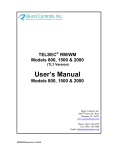
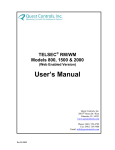
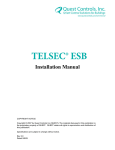
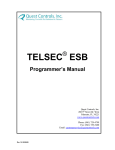
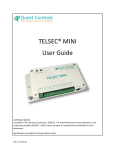
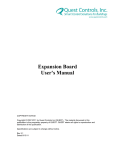
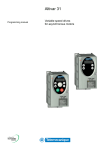
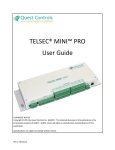
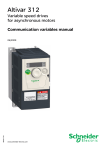
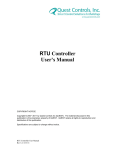
![[APPLICATION FUNCT.] (FUn-) menu](http://vs1.manualzilla.com/store/data/005824711_1-335fb64f289c00db4078a7c61d67b3e9-150x150.png)
